There's no pizza like sourdough pizza! With a crispy, chewy crust that is perfectly charred on top and bottom and loaded with all the good stuff.
We've developed an easy overnight dough that will hold all your favorite pizza toppings and bake to perfection every time, without a pizza peel.
Get your stretchy pants ready because you won't be able to eat just one slice!

We love all things sourdough around here, and pizza crust is right at the top of the list. Especially when it's this easy to make!
This is the perfect recipe to use with your leftover sourdough starter discard. Just like our cinnamon rolls, pancakes, and sourdough biscuits, plan to make the dough the night before you want to bake.
Let the dough ferment on the counter while you sleep and then pop it in the fridge the next morning. Your pizza dough will be waiting for you to bake when you get home from work and you'll be ready to get dinner on the table!
Be sure to check out the recipes for homemade pizza sauce and homemade pesto. The perfect compliment to your pizza!
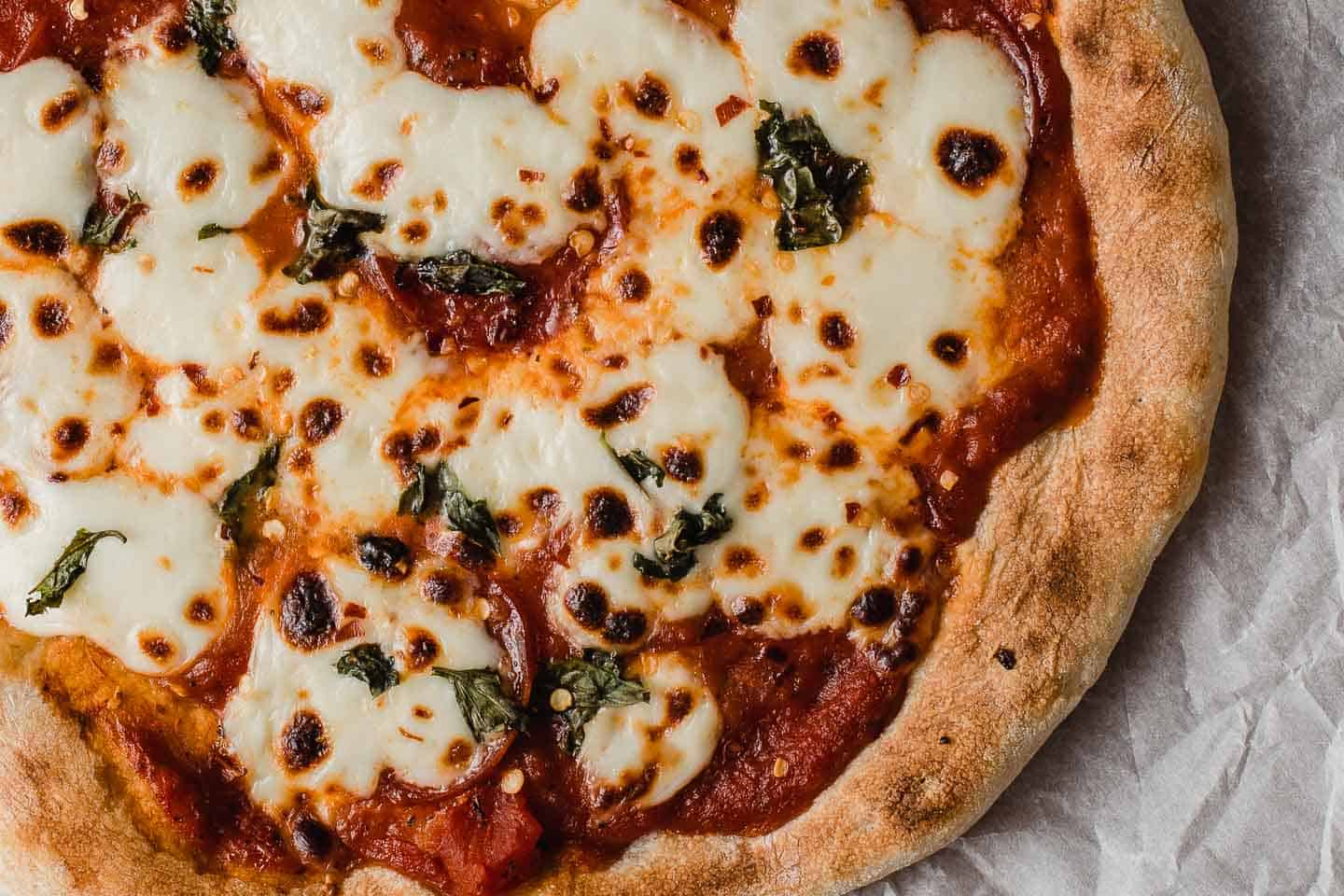
There are only a few steps standing between you and sourdough pizza crust bliss. Let's go over the basic steps, so you can get some in your belly, ASAP!
Jump to:
Sample baking schedule
Here's my baking schedule for family pizza night!
- 8 PM - The night before, mix the dough, cover the bowl, and let it sit at room temperature overnight.
- 8 AM - The next morning, perform one set of stretches and folds. Cover the bowl and place in the fridge until ready to cook.
- 5 PM - Remove the bowl of dough from the fridge.
- 5:30 PM - Cook pizzas.
Step-by-step instructions
STEP 1. Mix the pizza crust ingredients in a large mixing bowl until they come together and form a shaggy mass. Cover the bowl and let it ferment on the counter at room temperature overnight.
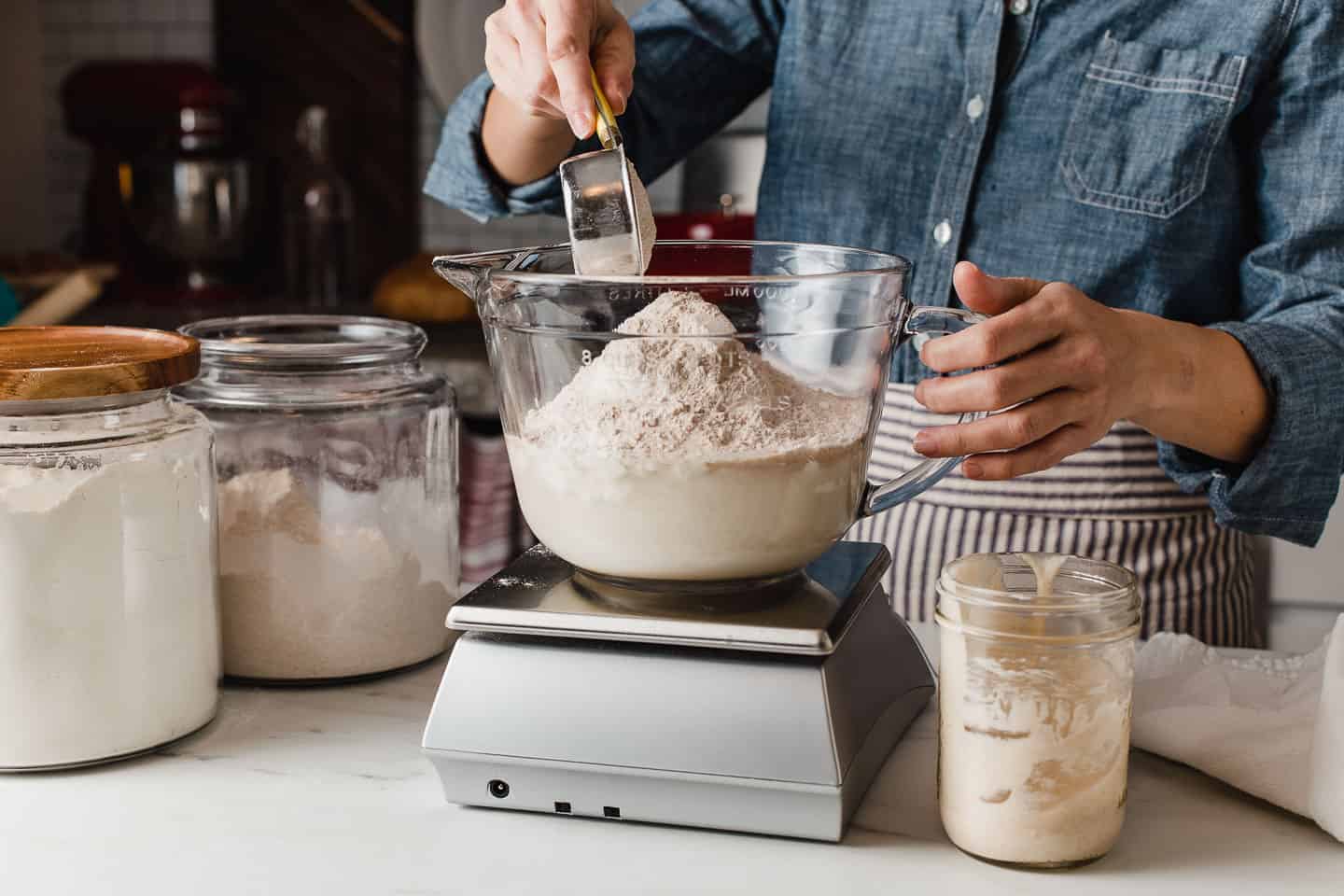
STEP 2. The next morning, perform one set of stretches and folds, cover the bowl, and place in the fridge until ready to bake. (The dough can be used to make the pizza crust at this point.)
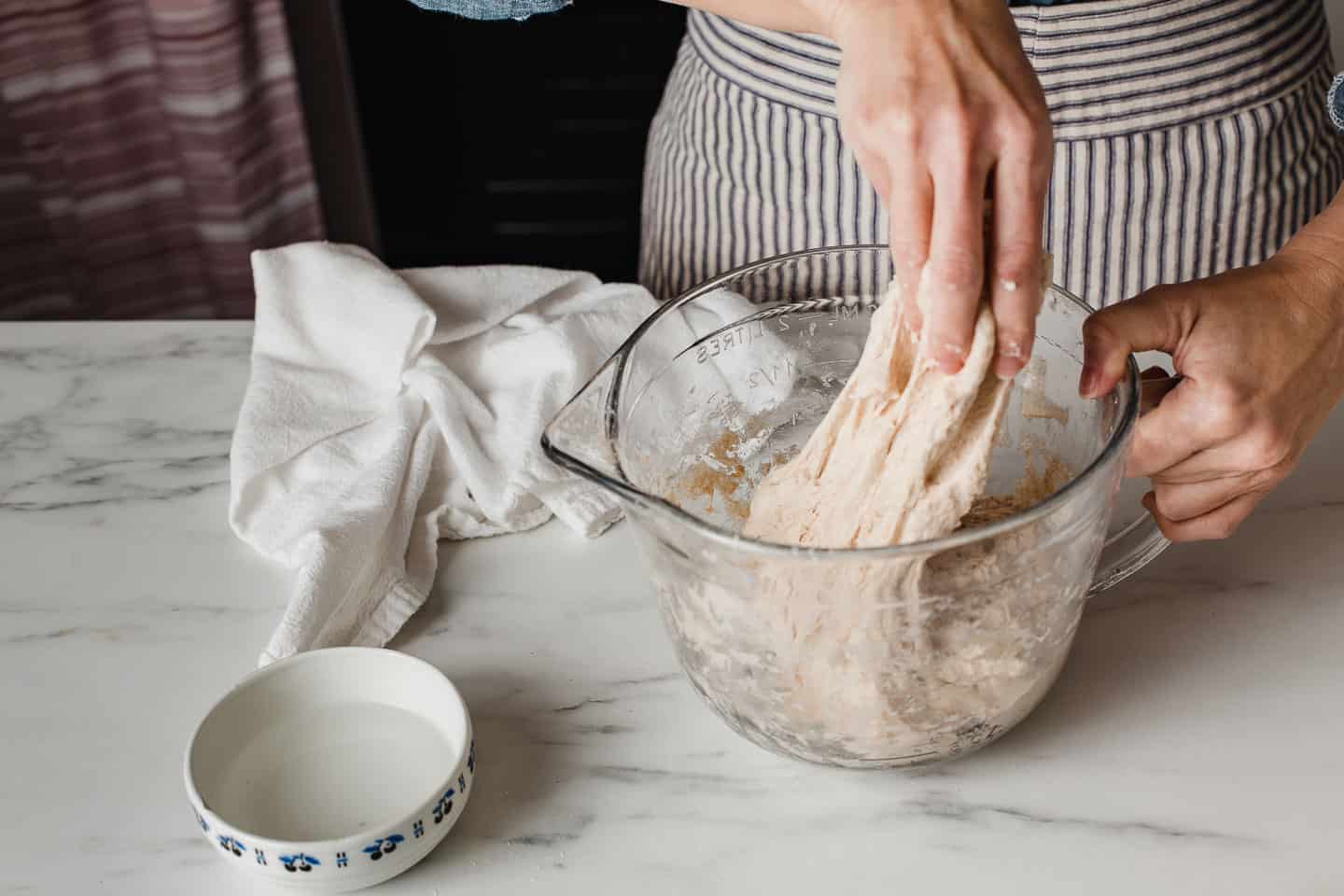
STEP 3. Remove the dough from the fridge and let sit at room temperature for 30 minutes. Divide the dough into 4 equal portions, flour your work surface, and shape each portion into a ball shape. Cover with a towel and let rest for 30 minutes.
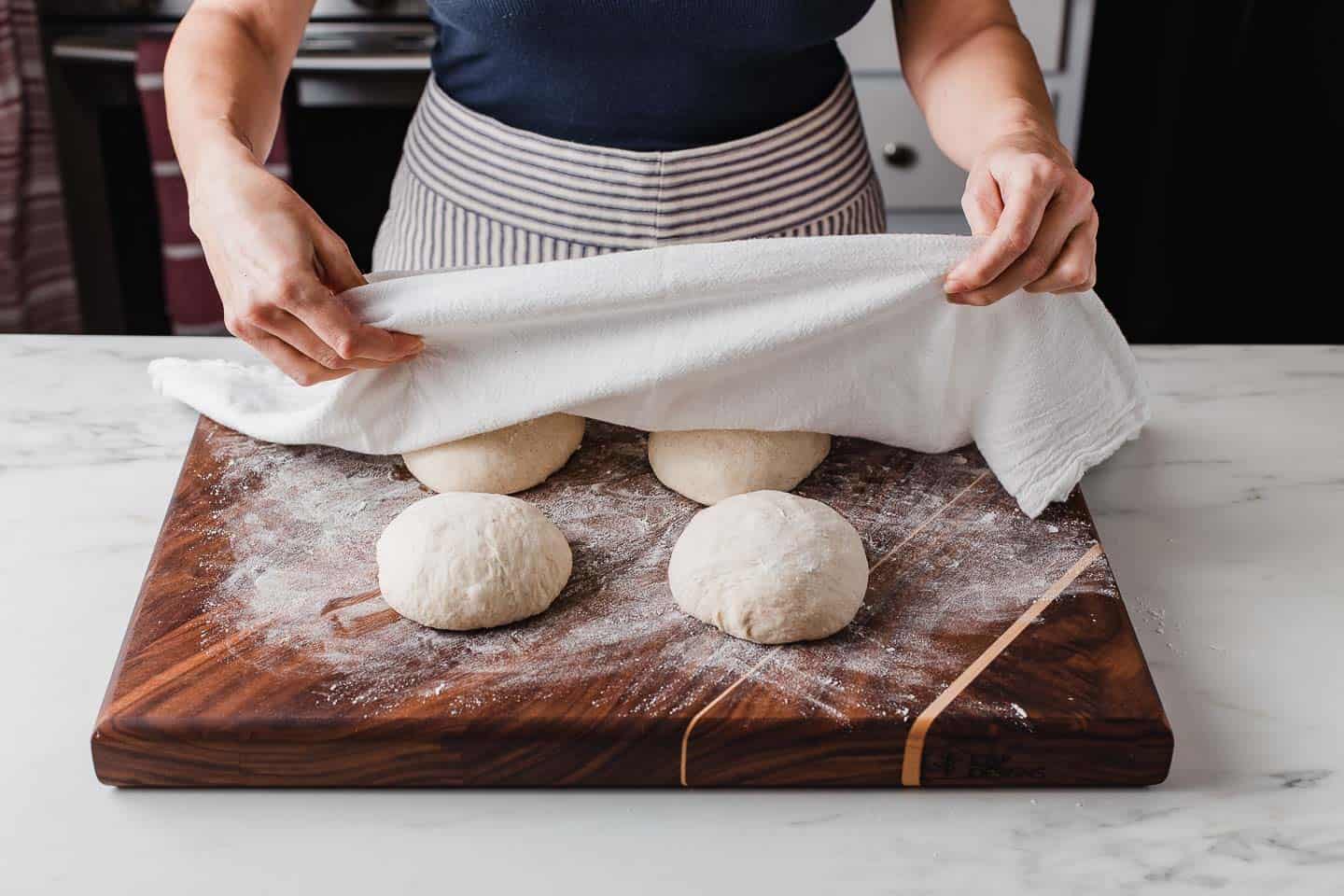
STEP 4. Turn your oven's broiler on HI and preheat your cast iron skillet over medium-high heat on the stovetop.
Working one at a time on a floured surface, press a dough ball into an 8" wide circle. If the dough is sticky, generously flour the work surface and the top of the dough as needed to prevent sticking.
TIP - If the dough is stiff and hard to shape, let it rest for 15-20 minutes to allow the gluten to relax. This will make it easier to stretch into a nice round shape.
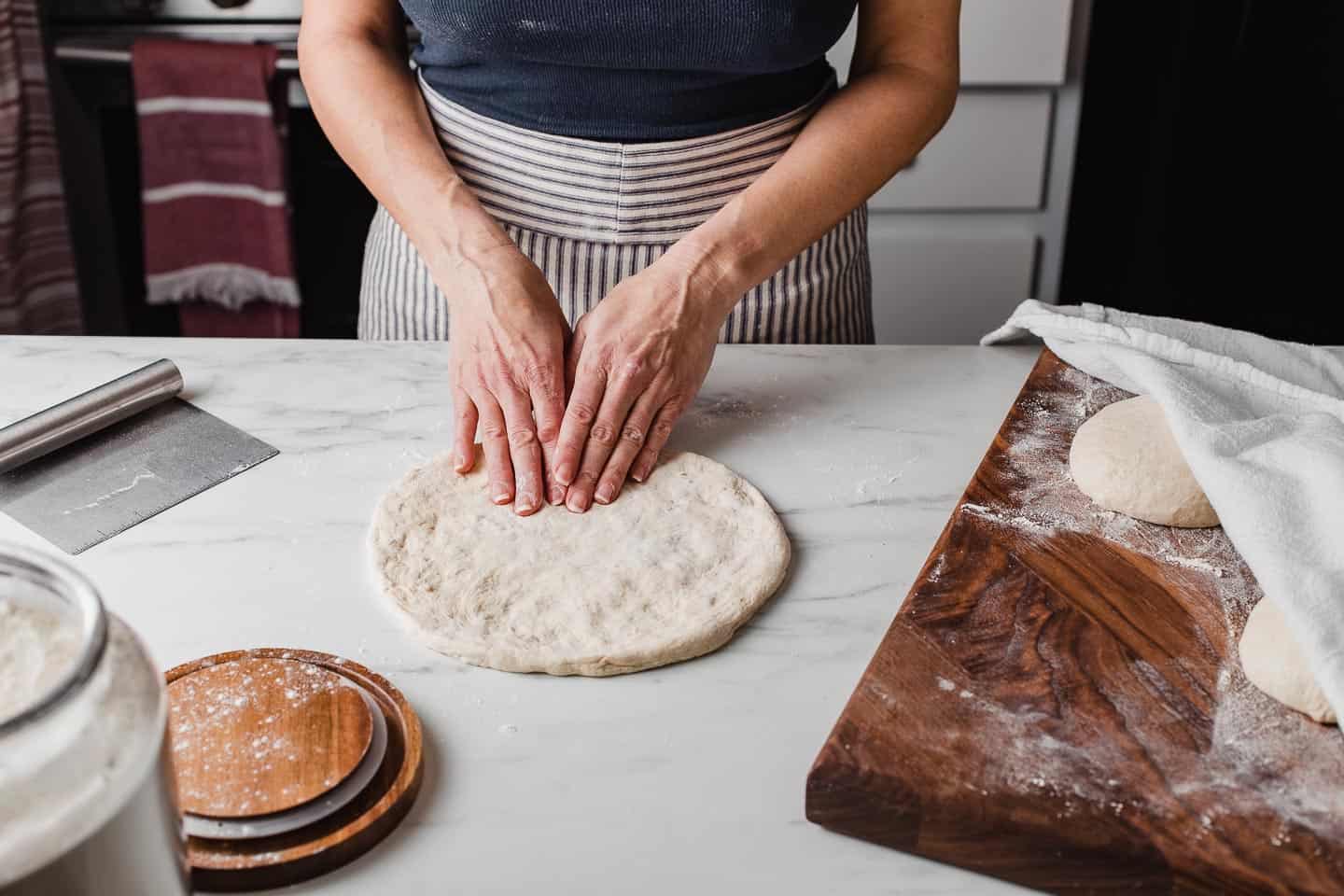
STEP 5. Carefully lay the crust into the hot skillet, making sure not to burn yourself.
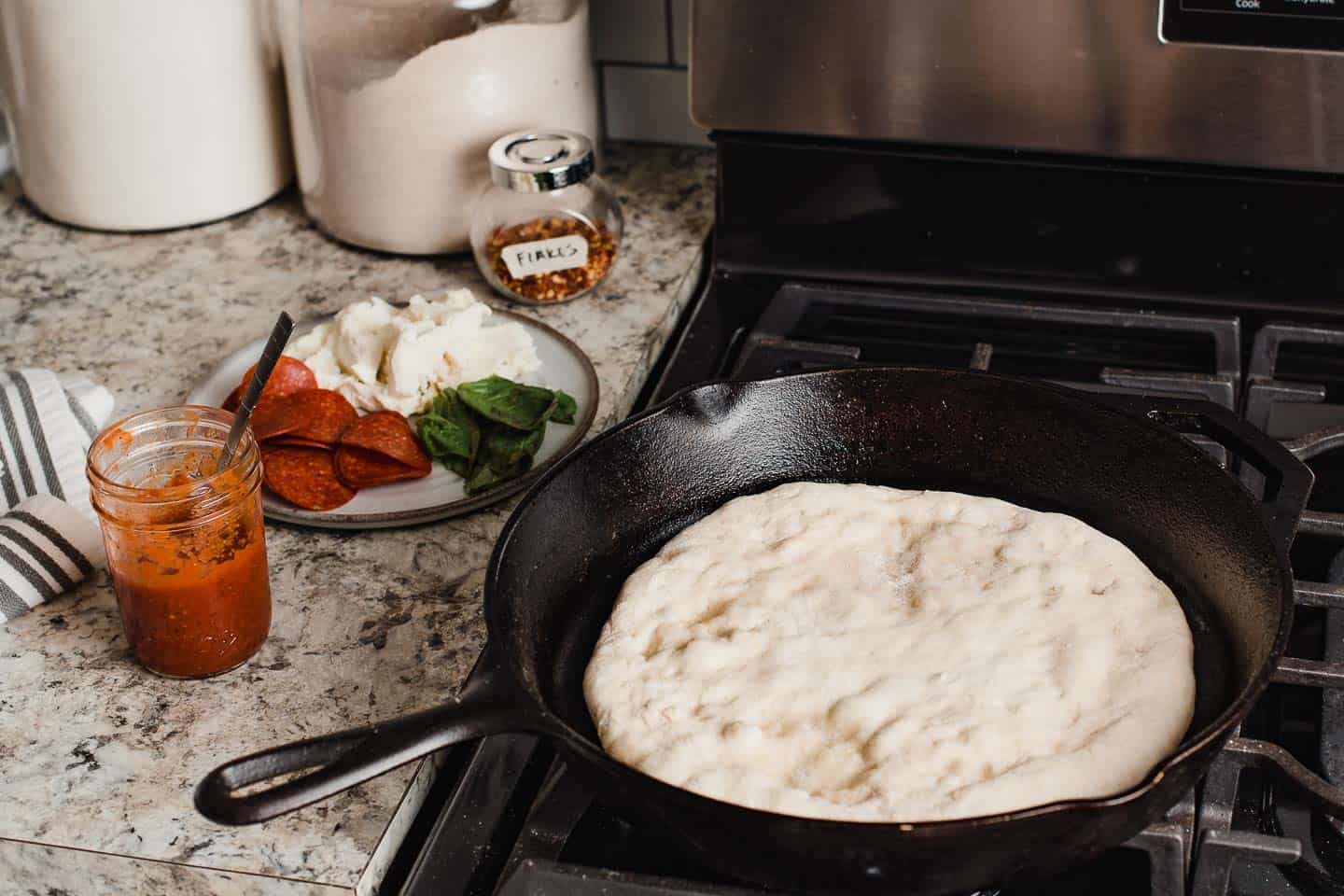
STEP 6. Immediately place your pizza toppings onto the crust. Cook on the stovetop for 5-6 minutes. Use a spatula to lift the crust in order to check the bottom for doneness. It should have a nice char.
Once the bottom is well cooked, transfer the skillet under the broiler for 2-4 minutes to cook the toppings. Check on the pizza frequently to avoid the crust and toppings from burning.
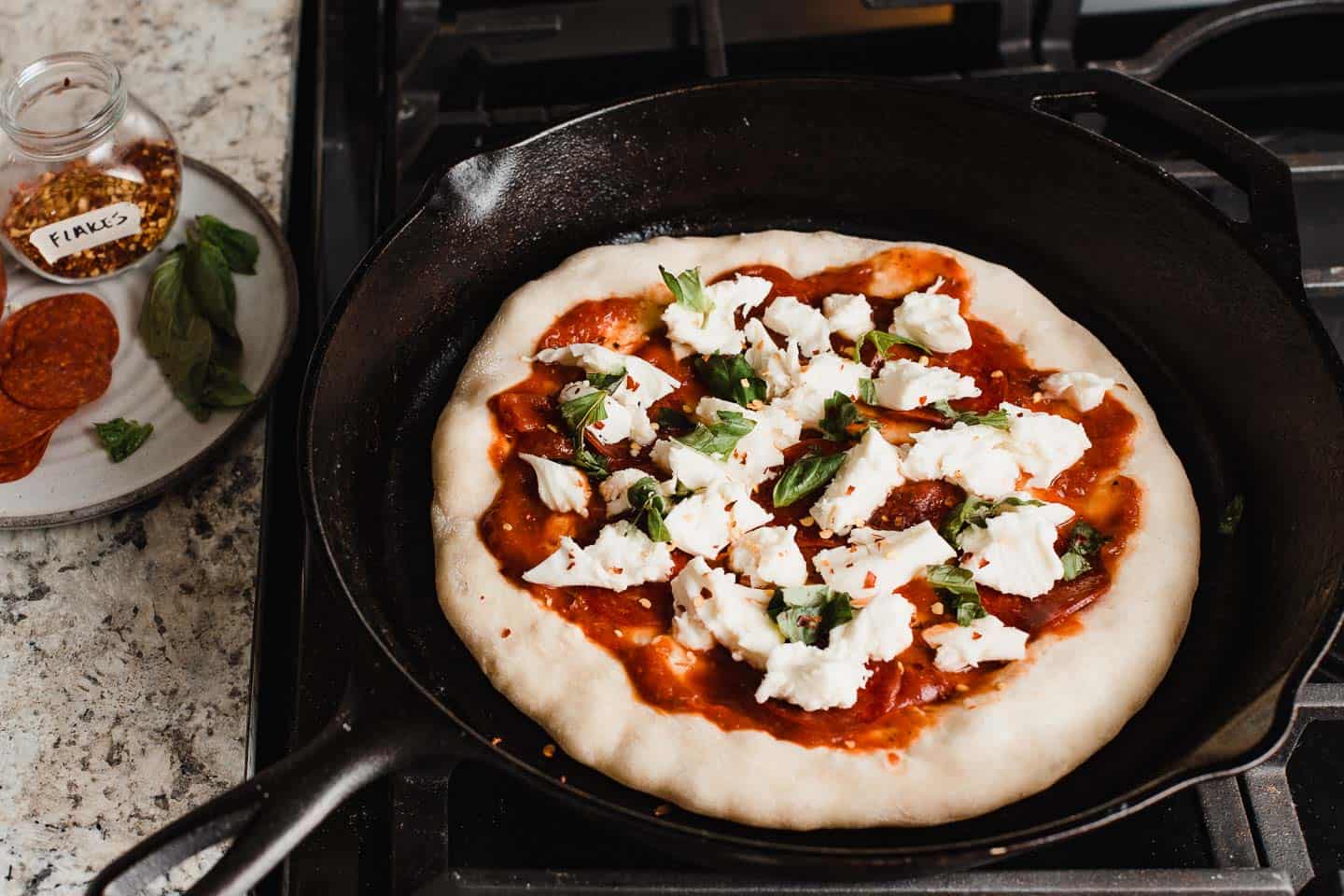
STEP 7. Remove the pizza from your oven and cut it into slices!
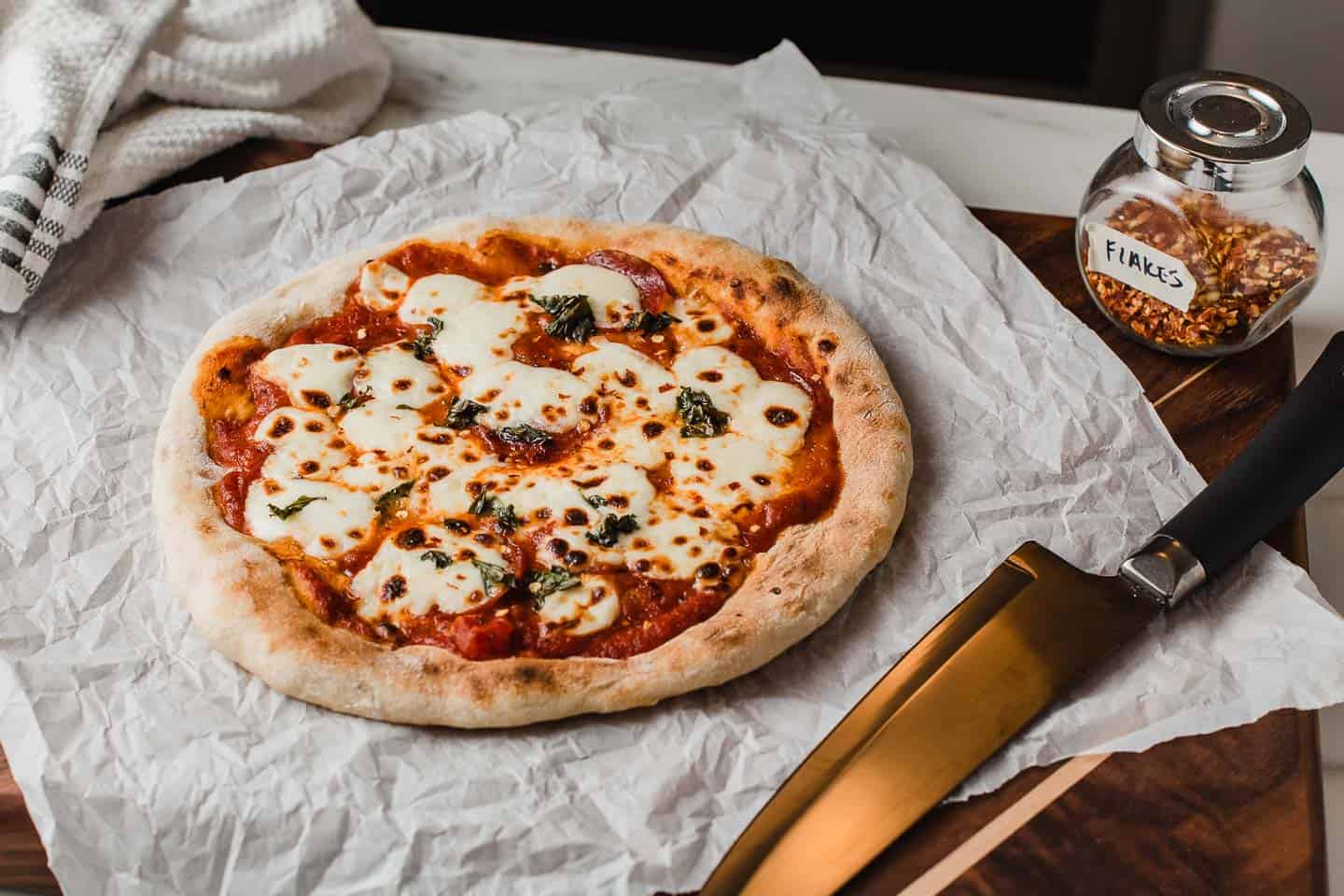
Cooking this sourdough pizza crust in a cast iron skillet makes all the difference! It's so easy to go from stove-top to broiler without messing up the pizza crust.
Tips for success
- If you do not have an oven-safe or cast iron skillet, start the pizza on the stovetop in a non-stick skillet. When the pizza is ready to go under the broiler, carefully slide the crust onto a baking sheet to finish it.
- Remember, don't be afraid to generously flour the work surface and the dough while shaping the pizza crust. Anytime your hands start to stick, add more flour.
- Have your pizza toppings ready to go before you shape the dough into the pizza crust. It only takes a few minutes on the stovetop before it's ready to pop into the oven to finish.
- This recipe makes (4) 8" pizza crusts. The dough can be divided in half to make (2) 16" pizzas.
Adjustments for high humidity and warmer weather
- In warmer months, reduce the amount of water by 25 grams in the initial mix. If the dough seems too stiff, slowly add the remaining water until you achieve the correct hydration level.
- You can adjust the flour measurements to 75g whole wheat flour and 425g all-purpose flour. Whole wheat needs more water than all-purpose, thus slightly reducing the hydration level of the dough.
How to freeze pizza dough
To freeze unbaked pizza dough, form the dough into 4 balls. Coat them with oil to prevent sticking and place each one into an individual freezer bag. Make sure to remove any air from the bag. Store in the freezer for up to 3 months.
When ready to use, thaw the dough in your refrigerator for 12 hours or overnight. Once you're ready to bake, remove the dough from the refrigerator and bring it to room temperature. Shape the pizza crust and bake according to the directions.
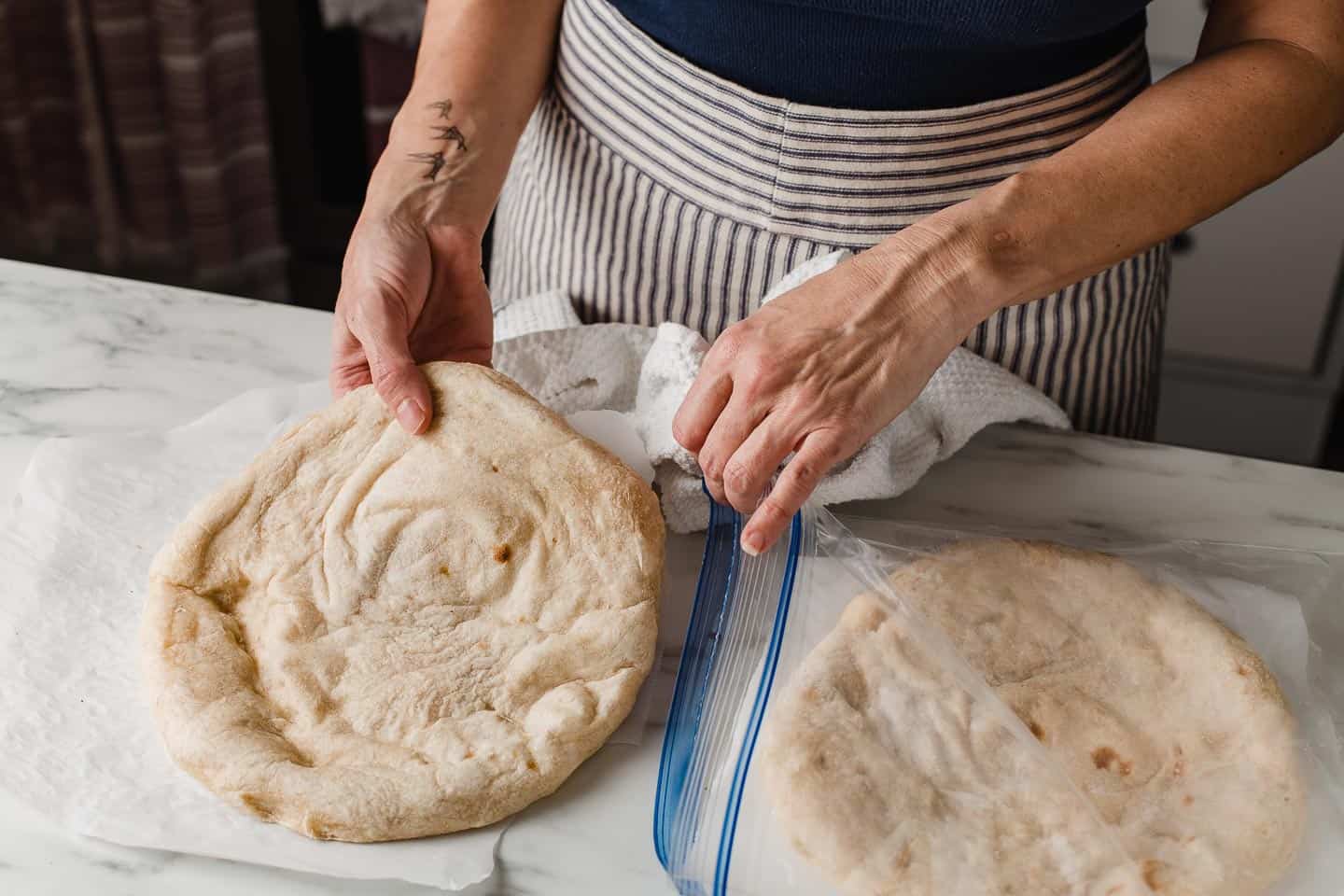
- Shape the crust and cook in the cast iron skillet over medium-high heat for 5-6 minutes. Finish under the broiler for 1-2 minutes.
- Let cool and freeze in a freezer-safe bag between sheets of parchment paper.
- When ready to bake, preheat your oven to 400°F (204°C). Remove the crust from the freezer and place on a baking sheet. (No need to thaw.) Add desired toppings. Bake for about 15-20 minutes or until the crust is golden and toppings are cooked through.

Recommended kitchen tools
- cast iron skillet (affiliate link)
Do you like this recipe? Make sure to subscribe to our newsletter and we'll send you fresh recipes, valuable troubleshooting advice, useful tips, and other information we believe will be helpful to you!
Other sourdough recipes you may like:
If you make this recipe let us know how it turned out! Leave a comment and a rating in the comment section below!

Sourdough Pizza Crust Recipe
EQUIPMENT
- Mixing Bowls
- Kitchen Scale
- 12" Cast Iron Skillet
INGREDIENTS
Sourdough pizza crust
- scant ½ cup (100 g) sourdough starter discard
- 2 teaspoons (10 g) fine sea salt
- 2 tablespoons (30 g) olive oil
- ⅓ cup + 1 tablespoon (50 g) whole wheat flour
- 3 ¾ cups (450 g) all-purpose flour
- 1 ⅓ cups + 2 tablespoons (350 g) water (see notes)
Pizza toppings
- pizza sauce
- homemade pesto
- your choice of toppings
INSTRUCTIONS
The night before
- Add the pizza crust ingredients to a large mixing bowl and use your hands to mix until they are fully incorporated. Cover the bowl and allow the dough to ferment at room temperature overnight.
The next morning
- Perform a set of stretch and folds. Wet your hand with water to prevent the dough from sticking. While the dough is still in the bowl, gently pull one side of the dough up and over itself. Turn the bowl and repeat this on all sides of the dough until you turned the bowl full circle.
- Cover the bowl and place in the fridge, up to 36 hours until ready to bake. (The dough can be used at this point to make your pizza, the cold ferment is optional.)
That night
- Remove the dough and let rest on the counter for 30 minutes to come to room temperature.
- Divide the dough into 4 equal pieces and on a generously floured work surface, shape each portion into ball shape. Cover the mounds with a tea towel let rest 30 minutes.
- Turn on your oven's broiler and heat a cast iron skillet over medium to medium-high heat. While the skillet is preheating, use your hands to press a ball of dough into an 8" circle on a floured surface. Use more flour as needed to prevent sticking. (If you find the dough difficult to shape into a pizza crust, let it to rest on the counter for 15 minutes in order for the gluten to relax.)
- When the skillet is hot, lay the circle of dough onto the skillet. Immediately place the sauce and toppings on the crust and cook for 5-6 minutes or until the bottom of the crust is starting to char.
- Once the bottom has turned brown and charred, transfer the cast iron skillet to the broiler to finish baking the top of the pizza 2-4 minutes. Remove, slice and serve hot.
NOTES
- This recipe has been EDITED on 12-15-20 from the original, with the following changes: water- reduced from 1 ½ cup (375g) to 1 ⅓ cup + 2 tablespoons (350g).
- If you do not have an oven-safe or cast iron skillet, start the pizza on the stove-top in a non-stick skillet. (If it is not a non-stick skillet, spray a little cooking oil to prevent the crust from sticking.) When the pizza is ready to go under the broiler, carefully slide the crust onto a baking sheet to finish it.




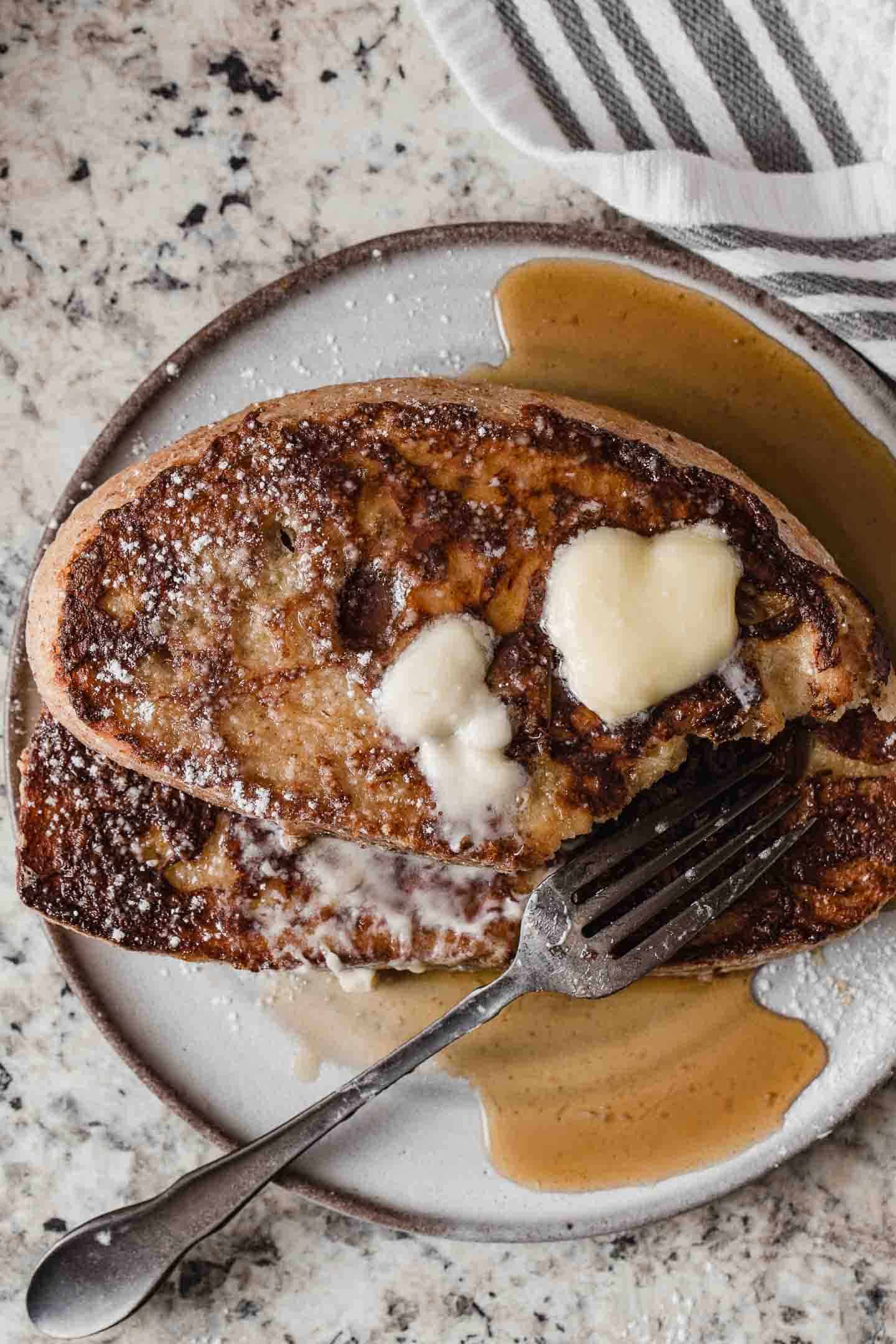
Dalyn says
I've made this recipe a few times now and we do love it ! but I came here to read the comments to see if anyone was having the same issue.. mine is super sticky! like all over my hands, stuck in the bowl and on the counter. I'm using the 350g of water (I see your notes saying it's been reduced already) but I'm wondering if I should use less? maybe it's the humidity in my air where I live. I do flour the surfaces to help prevent but wasn't sure if maybe I'm doing something wrong or need to adjust something. thanks for the info!
Amy says
Hi Dalyn, I would use 25 grams less next time. If the temperature of your kitchen is warm, that may be the issue as the dough can overproof and become sticky if it's too warm. If that's the case, reduce the amount of time your dough sits at room temperature next time.
Shannon says
When freezing the dough for future use, do you freeze prior to or after fermentation? Thank you!
Amy says
I freeze them after they have fermented.
Mallory H says
This was sooooo good! My kids have it 2 thumbs up! I love the textures of the dough-has a crunch yet soft and chewy as well. Will be making this again
Rachel B says
We. Are. Hooked! And I've made this for two other families, and they both asked for the recipe immediately! BRAVA!
INGE KOHL says
when putting the pizza under the broiler, how close do you put it? Top rack?
Amy says
I have found that the second from the top rack works great in my oven, so that's where I recommend you start.
Emily says
What do I do if I made this recipe this morning but want it for dinner tomorrow night?
Amy says
You can keep it in the fridge for up to 2 days until you are ready to cook it.
Salvatore says
I make two 16 inch pizza doughs and cook them in my outdoor oven at 450 degrees for 5 minutes. Thin crust and chewy.
Thank you Amy!
Amy says
That sounds amazing! 🙂
INGE KOHL says
Is your outdoor oven a pizza oven or a regular oven? I was wondering about baking the pizza on my stone in the oven.
Manon says
Does the sourdough starter need to be fed? Or can we use an unfed starter?
Amy says
You can use unfed starter!
Chantel says
Do you have to have whole wheat flour or can you use more all purpose flour?
Amy says
You can use more all purpose.
Michelle says
Thank you so much for all that you do. I just wanted to confirm with you that after mixing the ingredients you leave on the counter and don't do stretch and folds until the morning? Your video and instructions contradict a bit, but I wanted to make sure I get it right. Also, the instructions say to do one set of stretches, but then in one of the comments you say 4-6? Thank you again.
Amy says
Hi Michelle, you can do the stretch and folds at either point. I like to do mine right before I put it in the fridge. I do one set of stretch and folds and usually I turn the bowl 4-6 times, does that make sense?
Hiba Alhaj says
Hello, I haven't trued this recipe yet but it seems easy enough for a beginner like me, I hope I’ll have success with it like other commenters did. I have one question though, does it work with all whole wheat flour? And if so how would you recommend adjusting water added? Thanks a ton!
Amy says
Hi Hiba! I have a new whole wheat pizza dough recipe coming out soon. We use half whole wheat and half all-purpose flour for best results. We added a teaspoon of molasses and used 350 grams of water.
Hiba Alhaj says
Thank you very much for your reply. Will be looking forward to that one 😊